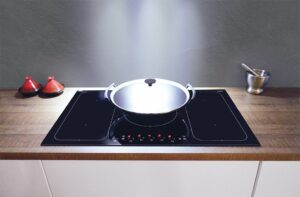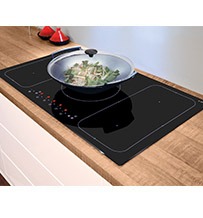
CDA Buying Advice – Hobs: What is a bridging hob?
If you’re looking to buy a new induction hob, you will probably start to see a lot of technical terms and functions popping up. It can be hard to know what is necessary, what is a luxury and what sounds incredibly important but is ultimately irrelevant to your own cooking style.
One of the functions you will see come a lot is a ‘bridging function’. If you want to combine cooking zones, use griddle pans or large based saucepans, they can be invaluable.
Many induction hobs with a bridge function will feature one or more ‘bridging zones’ on the surface. This large cooking area can be used separately by switching on either the front or back part of the zone.
On most hobs you will only be able to bridge two out of the four cooking zones, but this will leave you with another two zones to use for cooking space.
Alternatively, both zones can be switched on together to form one, extra-large cooking area. The bridging function makes it easy to use a large or oddly shaped pan or casserole.
As well as induction hobs with a bridging function, keep your eyes peeled for functions like overflow and overheat which can protect your hob, your cookware and even your meals.
With an overflow function, your induction hob will detect if the contents of your pan starts to boil over, it will identify when the temperature of the hob surface gets too high. If this does happen, these functions will turn down the heat in that cooking zone to save you from damaging your pans and burning your dinner!
Many induction hobs will have a boost function, which increases the power to one of the cooking zones so that you can heat pans much quicker. This is perfect for bringing pasta water or stovetop kettles to the boil quickly.
Not forgetting the timer that we have built into the bridging hob range that can be set up to 99 minutes for precision cooking and complete control.
For more tips on how to pick an induction hob, take a look at our buying guide.
One of the functions you will see come a lot is a ‘bridging function’. If you want to combine cooking zones, use griddle pans or large based saucepans, they can be invaluable.
What is the bridging function on an induction hob?
A bridging hob is a cooking surface that allows you to adjust the size of cooking zones to suit your requirements. This frees up many more sizes and types of pan for use, including griddle plates and fish kettle styles. The bridging technology works by the controls allowing a selection between single cooking areas and combining them to create larger zones. You can literally create an internal ‘bridge’ that joins the front left cooking zone to the rear left zone, for example.Many induction hobs with a bridge function will feature one or more ‘bridging zones’ on the surface. This large cooking area can be used separately by switching on either the front or back part of the zone.
On most hobs you will only be able to bridge two out of the four cooking zones, but this will leave you with another two zones to use for cooking space.
Alternatively, both zones can be switched on together to form one, extra-large cooking area. The bridging function makes it easy to use a large or oddly shaped pan or casserole.
How do I choose an induction hob?
Induction hobs are the newest type of hob available and they can come with a lot of additional features, designed to make cooking simpler.As well as induction hobs with a bridging function, keep your eyes peeled for functions like overflow and overheat which can protect your hob, your cookware and even your meals.
With an overflow function, your induction hob will detect if the contents of your pan starts to boil over, it will identify when the temperature of the hob surface gets too high. If this does happen, these functions will turn down the heat in that cooking zone to save you from damaging your pans and burning your dinner!
Many induction hobs will have a boost function, which increases the power to one of the cooking zones so that you can heat pans much quicker. This is perfect for bringing pasta water or stovetop kettles to the boil quickly.
Not forgetting the timer that we have built into the bridging hob range that can be set up to 99 minutes for precision cooking and complete control.
For more tips on how to pick an induction hob, take a look at our buying guide.

Model: HN6841

Model: HN9611

What is an integrated hob?
When it comes to hobs, integrated can be used to refer to the hob being built-in to your kitchen units. It can also refer to the extractor ‘hood’ which is now available built-in to certain induction hobs.An integrated hob and extractor hood can be a great investment as it saves space in your kitchen. Extractor hoods are also rarely the most attractive addition to a kitchen, which is another benefit to not needing a separate one.
Nowadays, things have advanced enough to allow us to refine the integrated 2-in-1 hob that features induction technology with both a bridging function and an extractor fan – a truly multifunctional appliance designed with life in mind.
What styles of kitchen does this pair with?
Induction cooking and especially bridging technology suits any kitchen where flexibility and performance is required.If you have a traditional home, a bridging hob can be installed discreetly to provide functional, efficient and modern cooking performance without interfering with the standout features of your home.
Like entertaining? Then a bridging hob is ideal for creating a chef’s cooking space that allows you to move pans back and forth for attention.
If your look is ultra-modern, the black glass design will look seamless and considered in the overall line of your kitchen.









